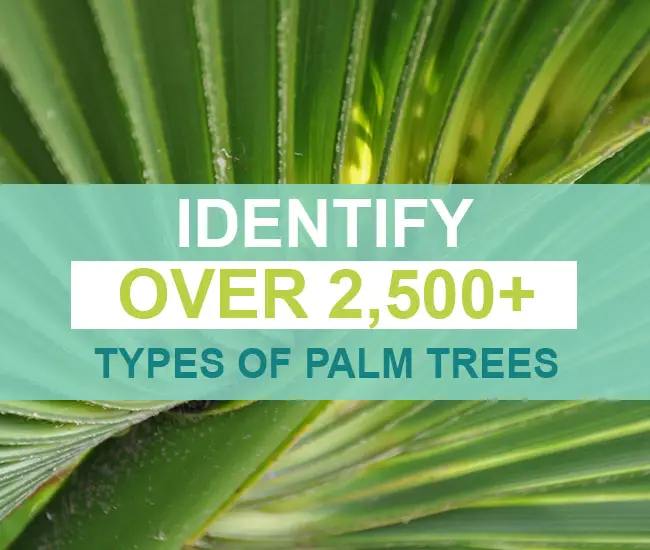
With a staggering 2,500+ species out there, pinpointing a palm tree’s identity can be quite the puzzle. No wonder my inbox is flooded with emails from people seeking a hand in palm tree identification. After all, different palms demand different kinds of TLC, and knowing their species is crucial.
Some palms are sun-worshippers, thriving in hot climates, while others prefer the cool shade and can withstand chilly temperatures. In my opinion, a palm’s cold tolerance is a significant factor; it can determine where it can thrive.
Now, when you’re out hunting for a palm at your local home improvement store or garden center, be aware that labels can sometimes be misleading. That’s why I always suggest shopping at a trustworthy nursery.
Some palms are sun-worshippers, thriving in hot climates, while others prefer the cool shade and can withstand chilly temperatures. In my opinion, a palm’s cold tolerance is a significant factor; it can determine where it can thrive.
When buying a palm from a home improvement store or a garden center, keep in mind, that it can be mislabeled. That is one of the reasons I always recommend buying palms from a reputable nursery.
In this post, I want to highlight key characteristics that I rely on to distinguish one palm species from another. Palms can be sorted out by their leaf shape, trunk style, flowers, fruit, and size.
How to Identify a Palm Tree Step-By-Step
Step 1: Leaf Type
When you’re on a mission to identify a palm tree, the first thing to check out is the leaves. Are they fan-shaped, feather-shaped, or perhaps something different altogether?
Step 2: Crownshaft
Next up, take a look at the crownshaft – that elongated leaf base. What color is it sporting?
Step 3: Leaf Stems
Now, let’s examine those leaf stems. Do they come with teeth, or are they smooth? And what’s their color?
Step 4: Trunk Type
Moving on to the trunk. Is it single, or does it come in multiples? Does it have a smooth surface, or is it hiding under a layer of old leaf bases? Does it have any distinctive textures or a bit on the swollen side?
Step 5: Fruits and Flowers
Now, let’s dive into the fruity details! What’s the color of those blossoms? And when it comes to fruits, what’s it producing? Also, be sure to check the color of those fruits as well.
Step 6: Palm Size
Last but not least, how tall is this palm tree towering over you?
Palm Identification By Leaf Type
Palm leaves come in three main parts: the leaf base, the leaf stem, and the leaf itself. The leaf base, that’s where the stem forms a connection with the trunk. On many palms, you’ll notice that the leaf base remains on the trunk even after the frond drops off, leaving behind a unique pattern.
But let’s start with the basics – the leaves. When it comes to palm identification, you can generally classify them into three main leaf types: pinnate (feather-shaped), palmate (fan-shaped), and entire (simple).
Now, most palms fall into the pinnate or palmate categories, with the simple leaf type being quite uncommon. Additionally, there are a couple of subcategories worth mentioning – costapalmate and bi-pannate.
- Pinnate Leaf (Feather-shaped)
- Palmate Leaf (Fan-shaped)
- Costapalmate Leaf
- Bi-Pinnate Leaf
- Entire Leaf (Simple)
1. Pinnate Leaf (Feather-shaped)
Pinnate fronds have separate, long leaflets that grow from the central stalk. You’ll spot this leaf type on popular palms like the Buccaneer Palm, Majesty Palm, Queen Palm, and Sylvester Date Palm.
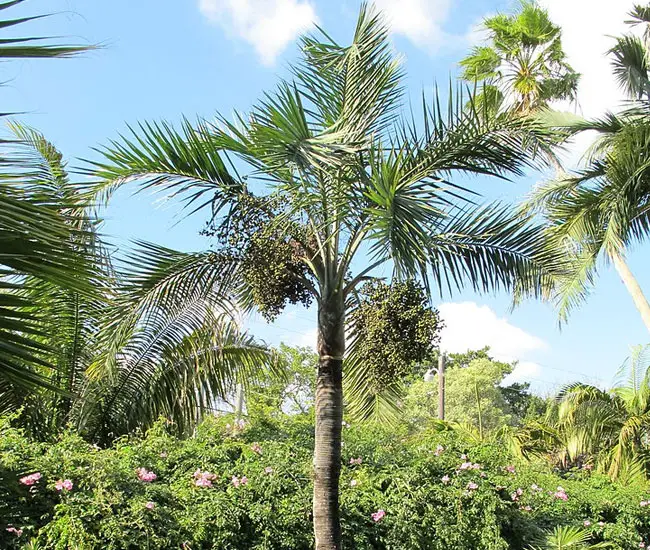
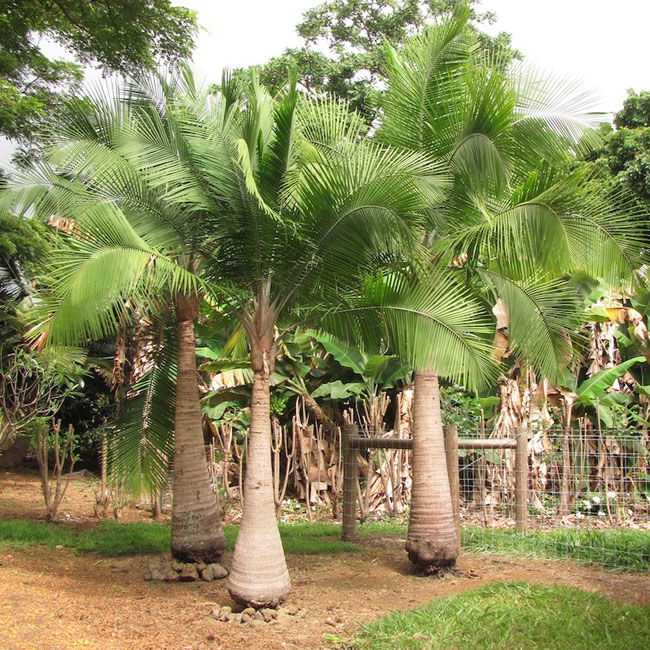
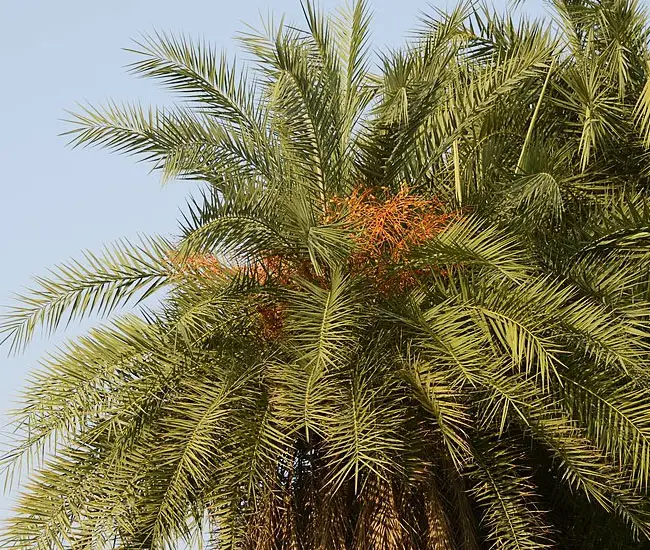
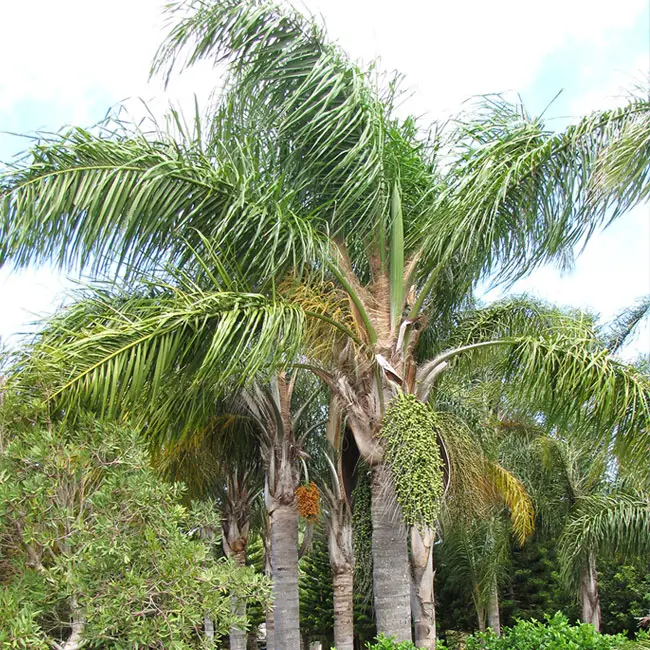
2. Palmate Leaf (Fan-shaped)
Fan-shaped fronds radiate from a central point along the stem, much like the fingers on your hand. Some well-known palms rocking this look include the Everglades Palm, European Fan Palm, Windmill Palm, and Ruffled Fan Palm.
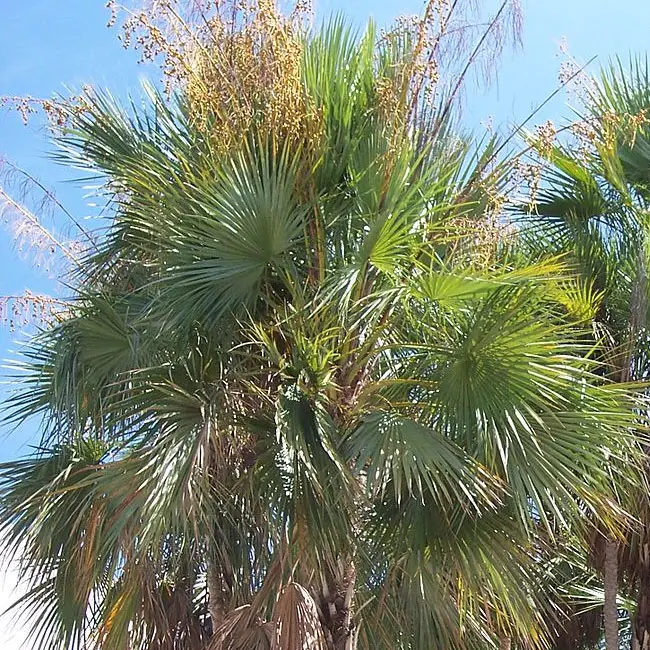
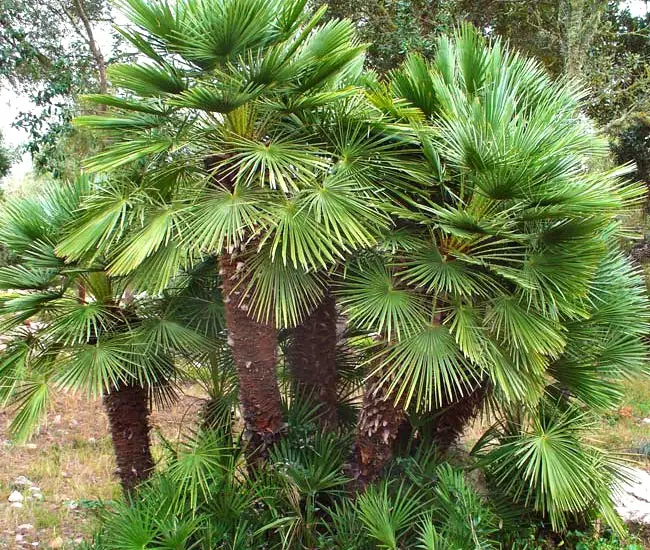
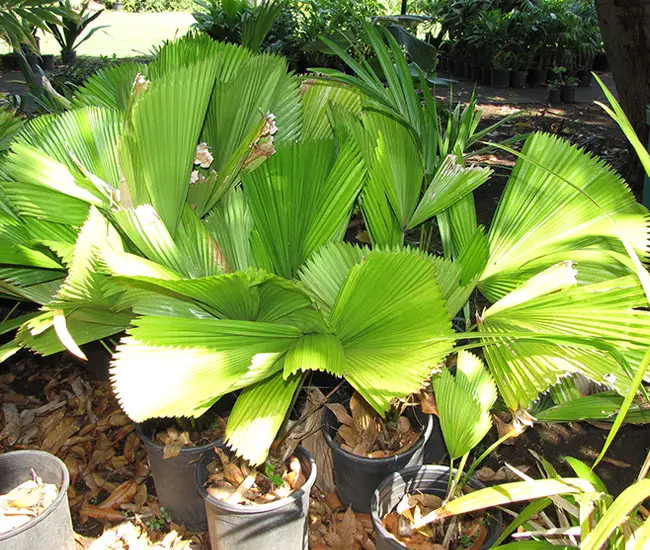
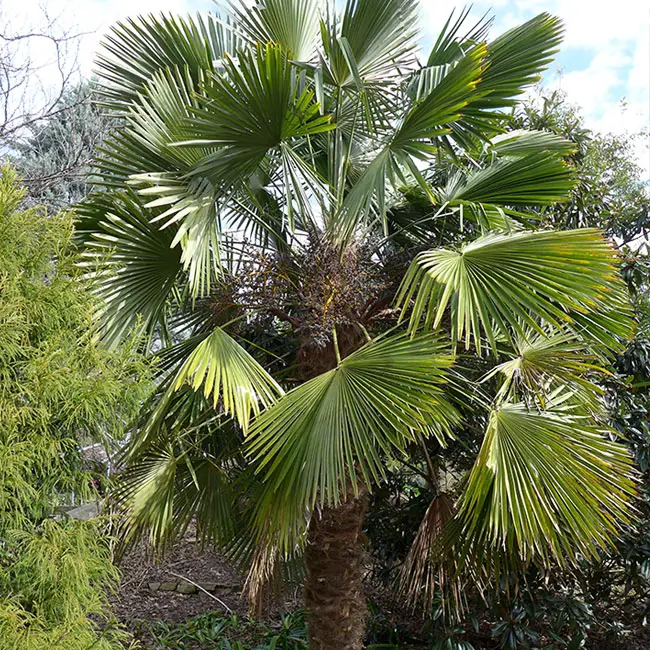
3. Costapalmate Leaf
Costapalmate palms, a subcategory of the fan-shaped crew, are like a stylish blend of palmate and pinnate. Instead of a center point, they have a short midrib from which leaf segments branch out.
These leaves often have sharp twists and folds at their tips. Consider Blue Latan Palm, Red Latan Palm, Fiji Fan Palm, and Chinese Fan Palm as examples.
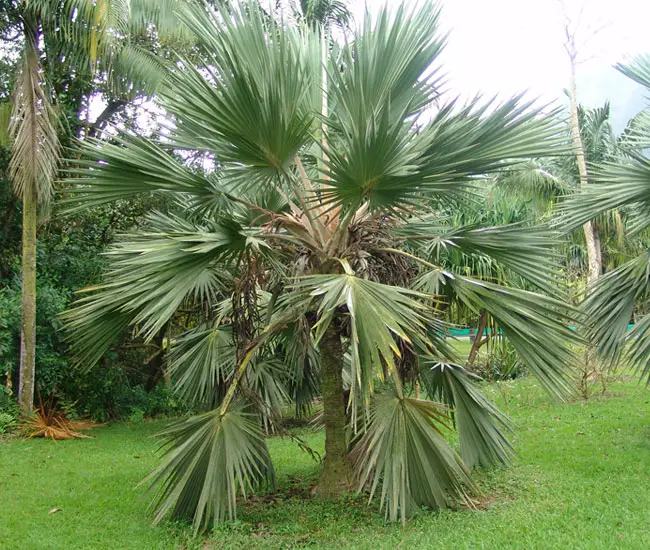
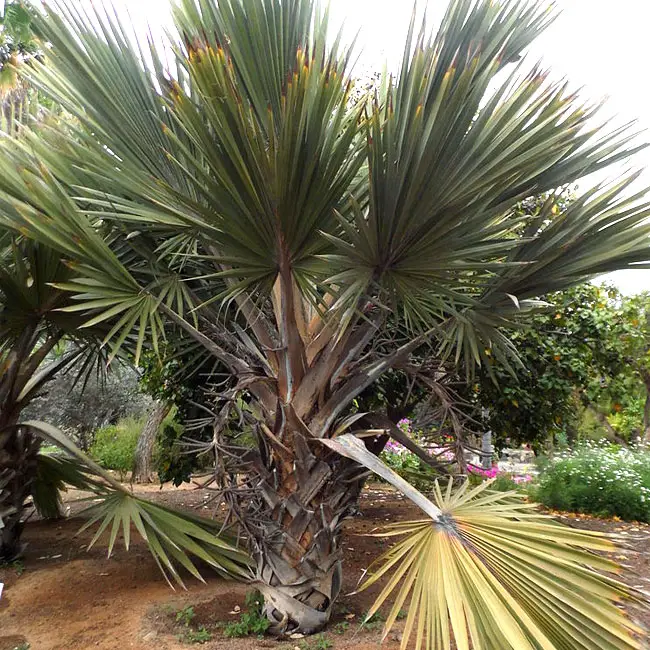
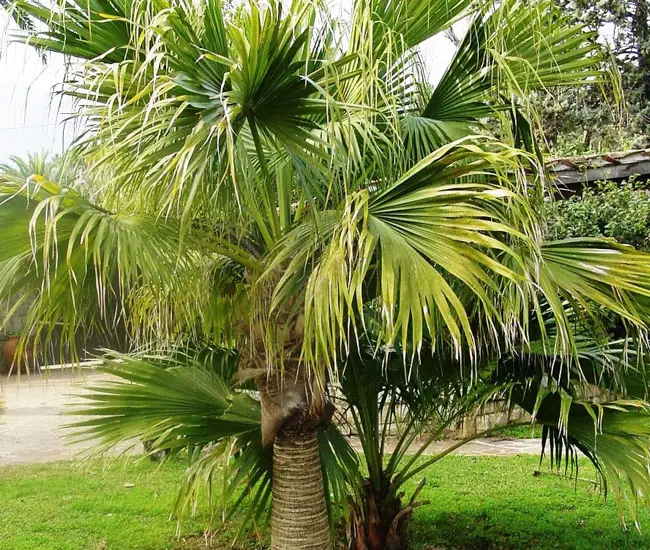
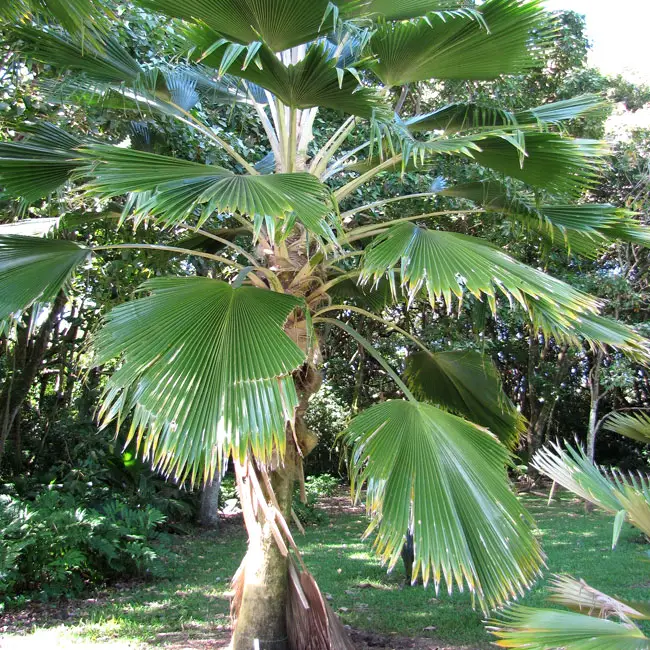
4. Bi-Pinnate Leaf
Bi-pinnate palms feature a secondary leaf stem attached to the primary one, with leaflets connected at regular intervals. You’ll only find this unique leaf type in one palm variety called the Fishtail Palm (Caryota).
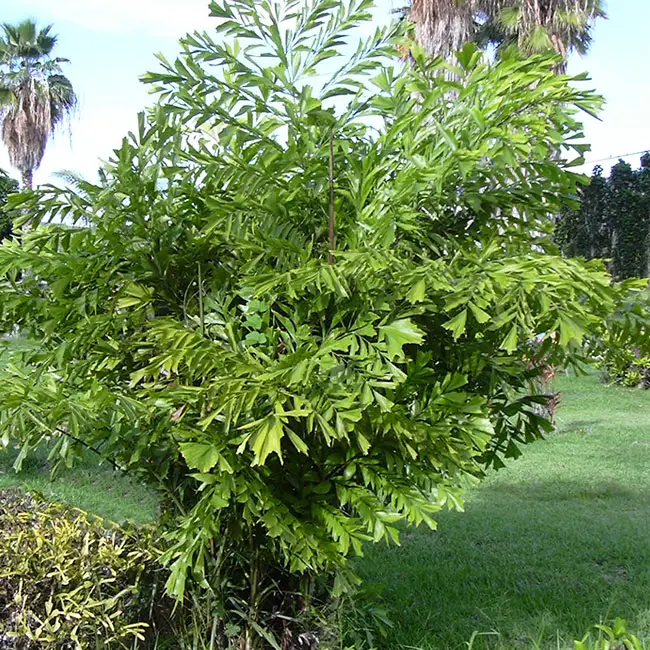
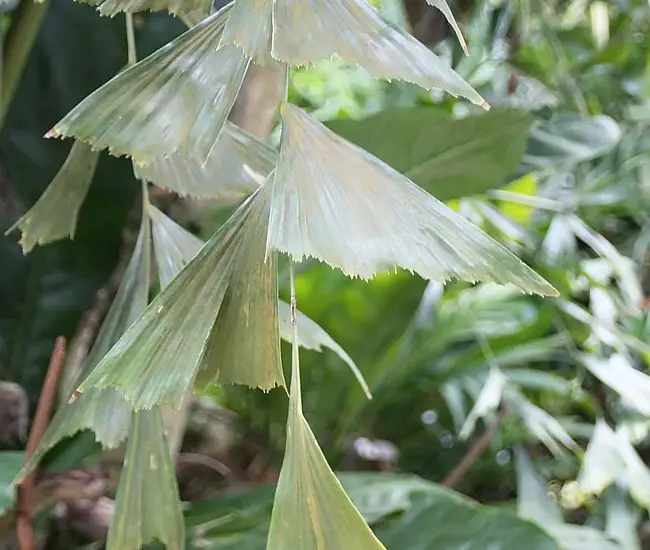
5. Entire Leaf
This one’s a unicorn too – the entire (simple) leaf type, composed of a single leaflet or blade that isn’t divided into individual leaflets. Check out the Joey Palm and Miniature Fishtail Palm for some examples.
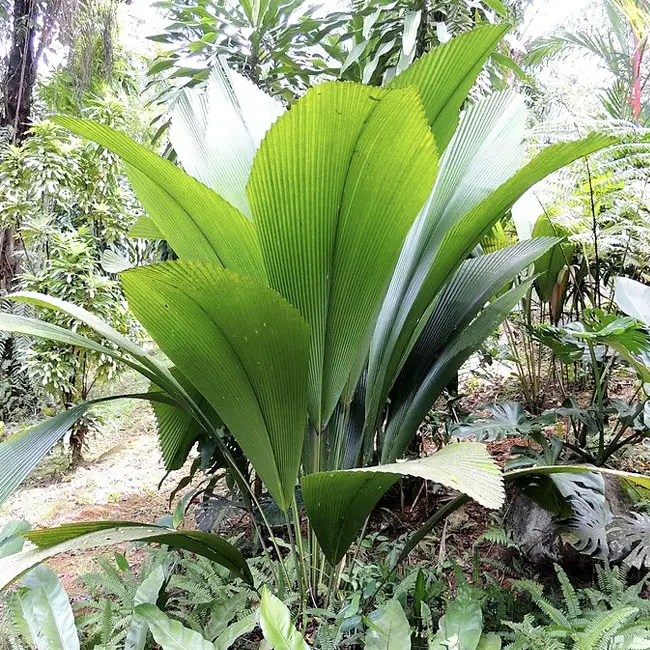
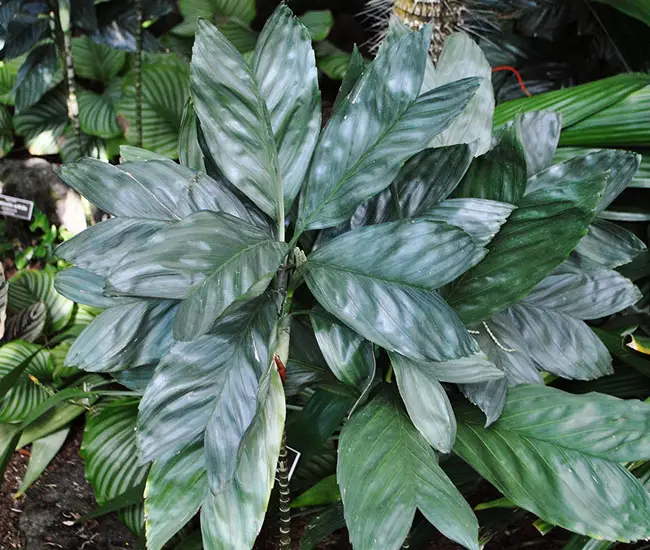
Palm Identification By Crownshaft
On certain palms, leaf bases create a smooth and waxy structure known as a crownshaft. Crownshafts can come in various colors compared to the trunk.
For instance, the Lipstick Palm boasts a striking red crownshaft, while the King Palm sports a reddish-purple one. Palms with crownshafts are known to be “self-cleaning,” meaning their dying leaves drop to the ground without needing any pruning.
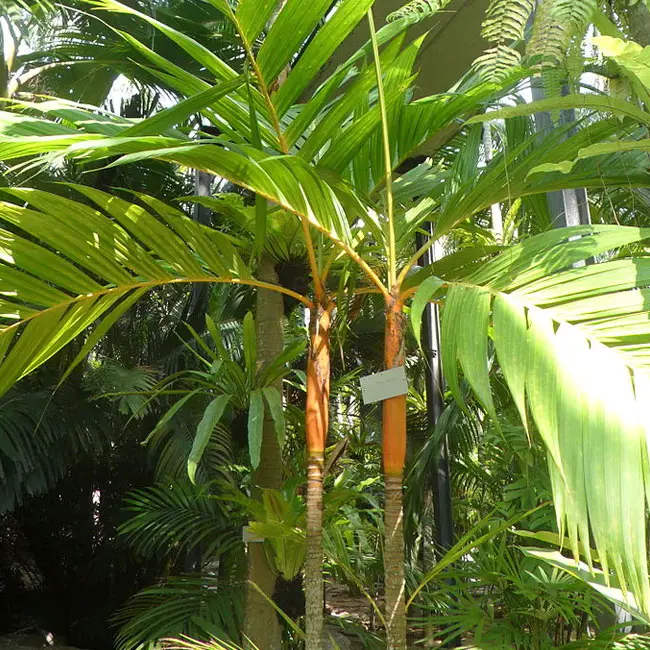
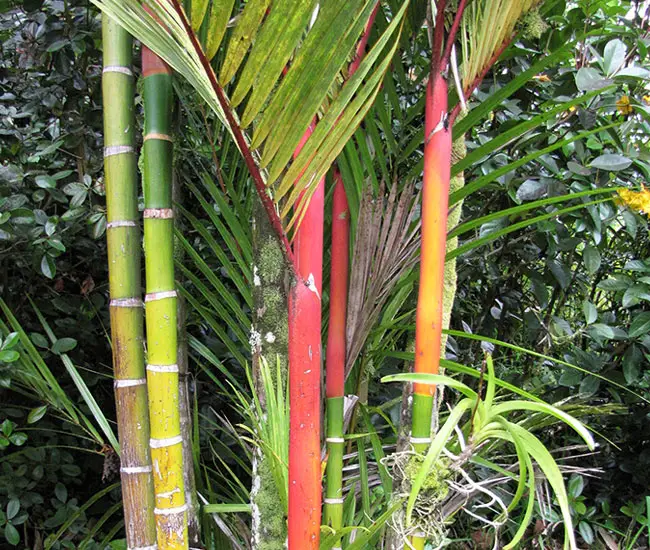
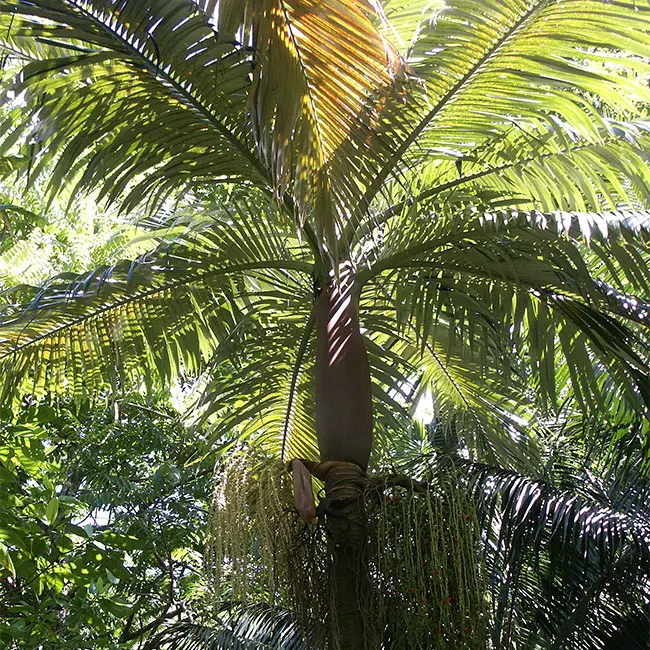
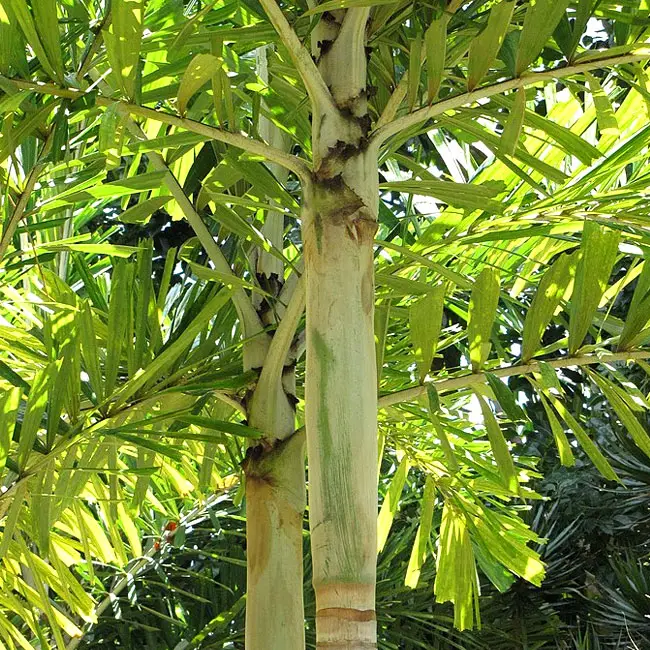
Palm Identification By Leaf Stems
Leaf stems can also serve as an identifying factor, displaying variations in color, size, and formation, with some sporting sharp teeth along the edges.
The Traveler’s Palm and Triangle Palm have unique leaf formations at their base, reminiscent of a peacock tail. The Bismarck Palm steals the show with its dramatic crown, complete with distinctive silver-green leaf stems and fronds.
Here’s another instance: the Taraw Palm, Bailey’s Copernicia Palm, and Date Palm boast stems adorned with sharp spines along their margins.
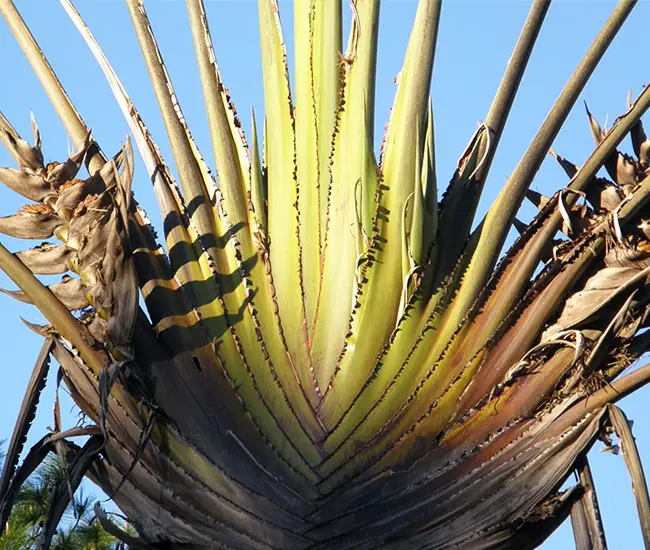
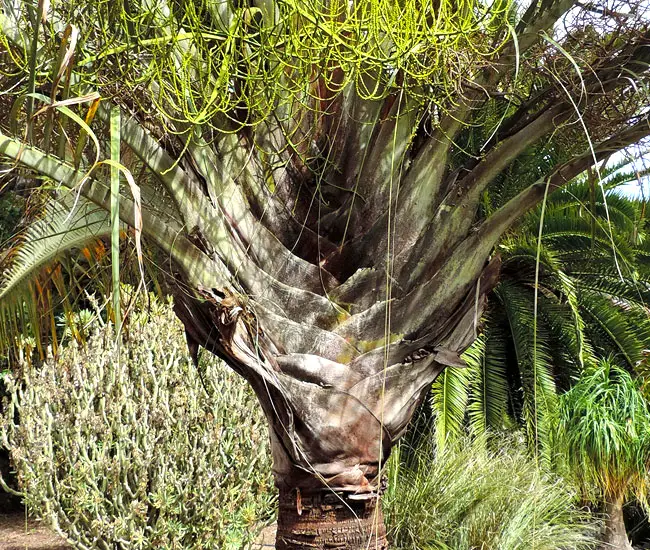
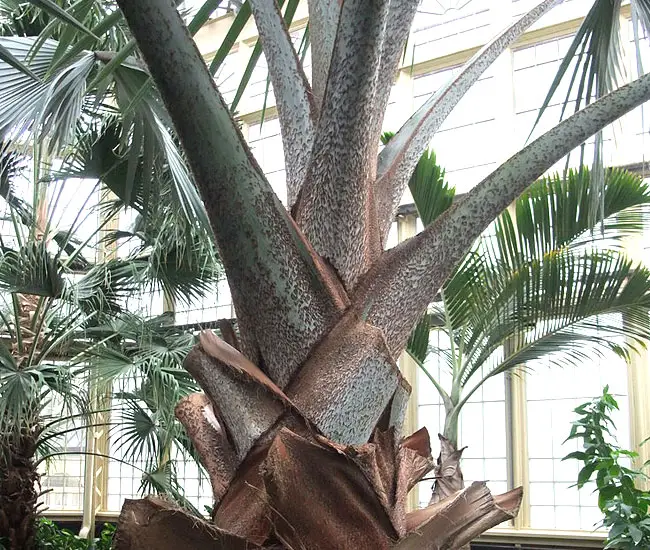
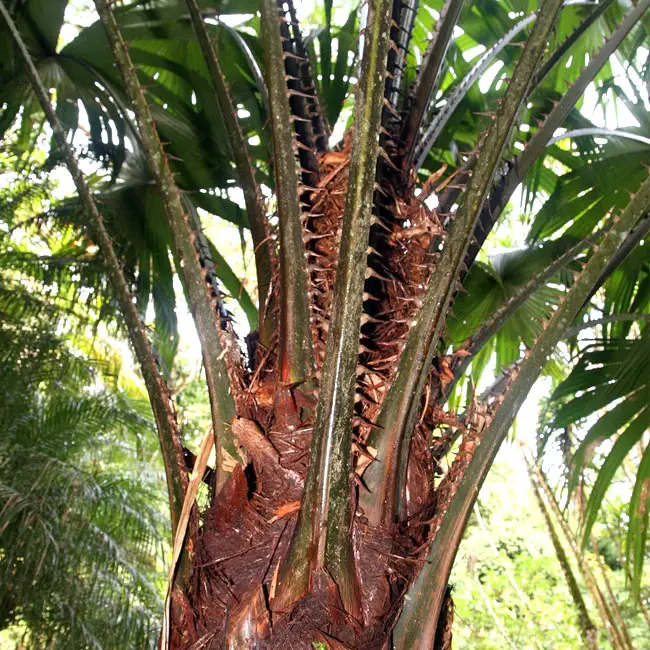
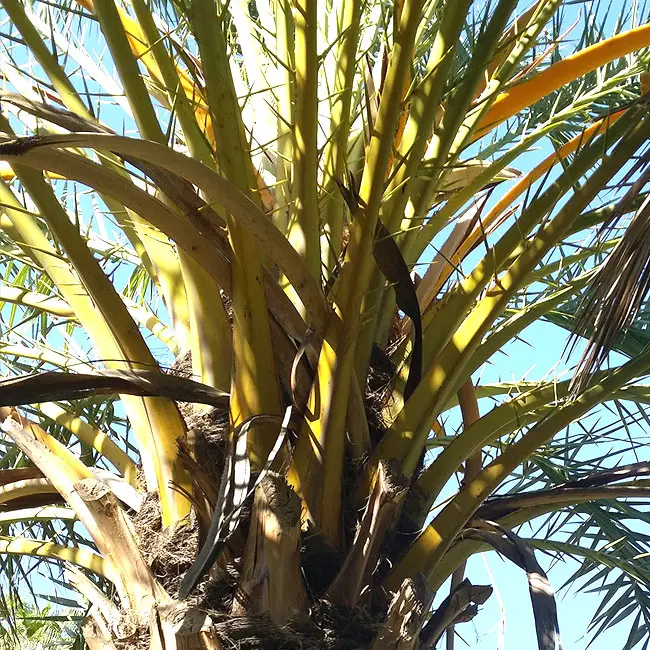
Palm Identification By Trunk Type
With an extensive 2,500 palm species at your disposal, the range of trunks is virtually limitless. Trunks come in all shapes and sizes, with a rainbow of colors, textures, and other unique traits to explore.
Let’s start with the number of trunks. Palms show off three different trunk types: solitary, multi-trunk, and some even go trunkless.
Solitary Trunk Palms
Most palms are solo acts, sporting a single trunk. Check out popular ones like the Foxtail Palm, Blue Hesper Palm, Princess Palm, and Bismarck Palm.
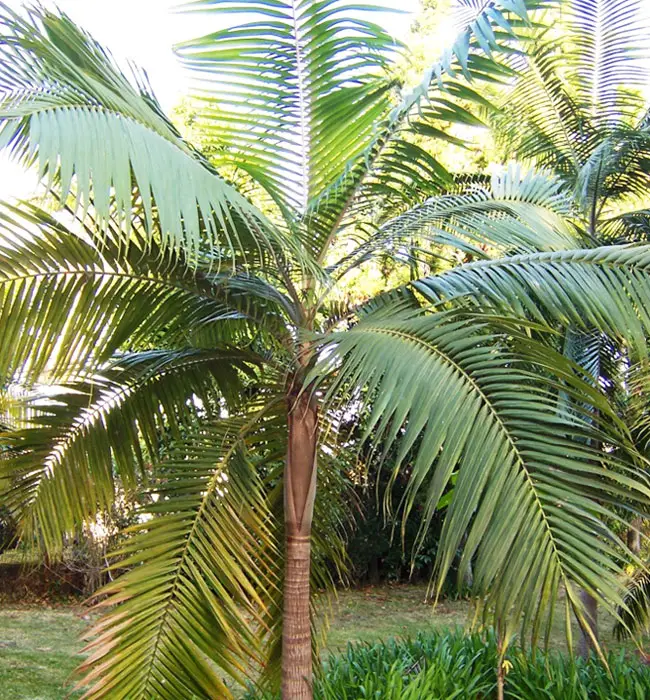
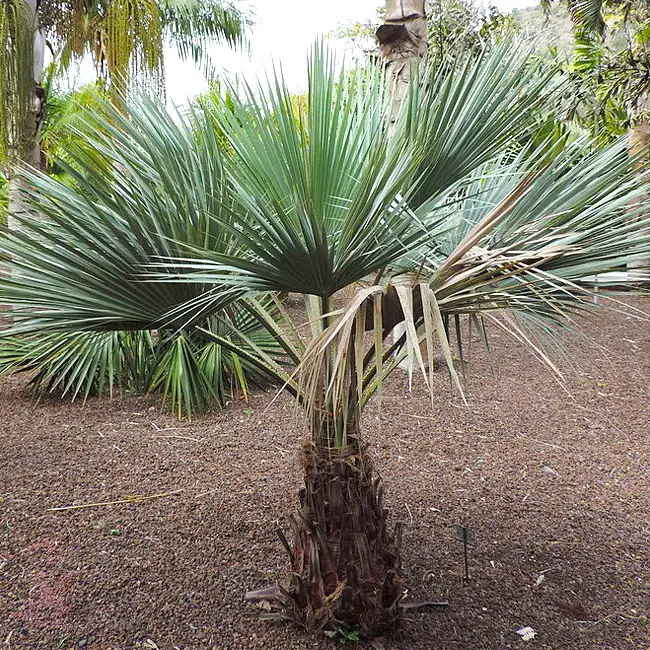
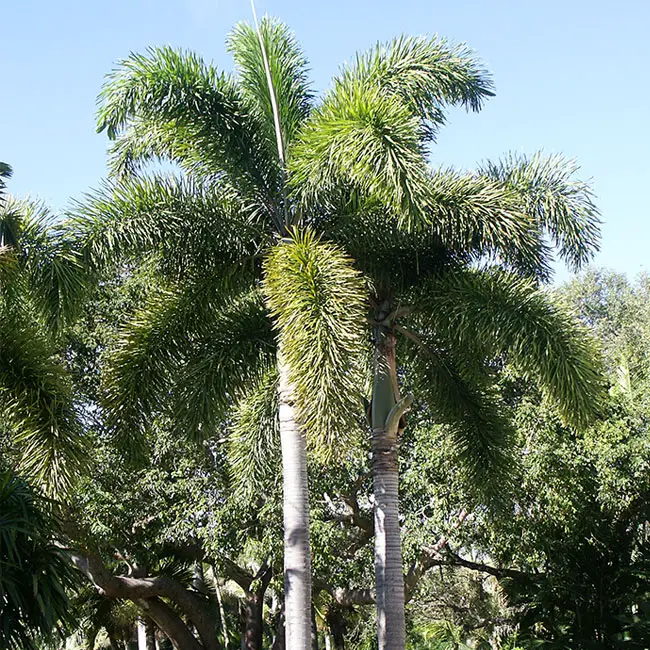
Multi-Trunk Palms
Multi-trunk palms are typically shorter and grow at a slower pace. Think of the Seashore Palm and Lady Palm – they’re like the shrubby, slow-growing rock stars of the palm world.
They’re perfect for creating privacy walls or adding flair to foundation plantings, not to mention they look great in outdoor tubs and planters.
The Acai Palm and Areca Palm may grow faster but still flaunt clustering trunks that are sleek and clean.
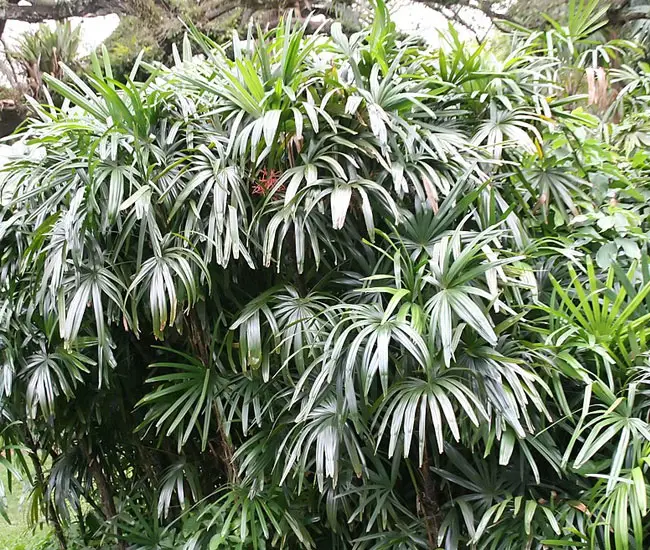
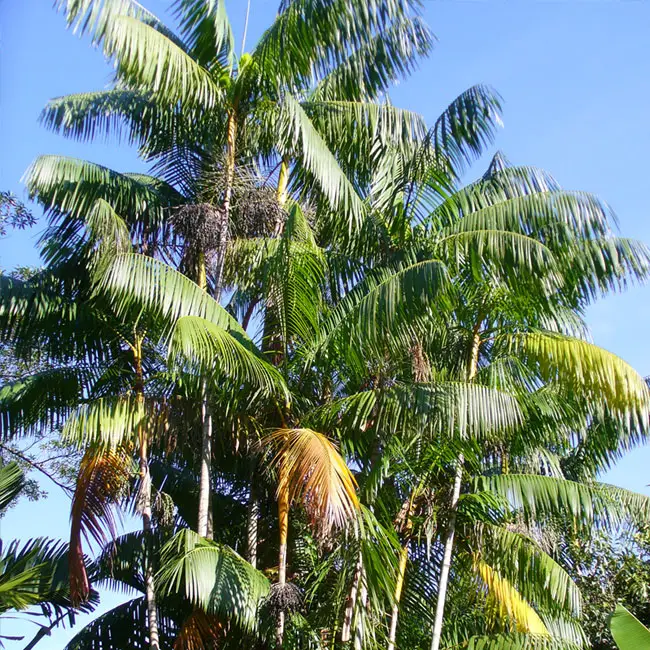
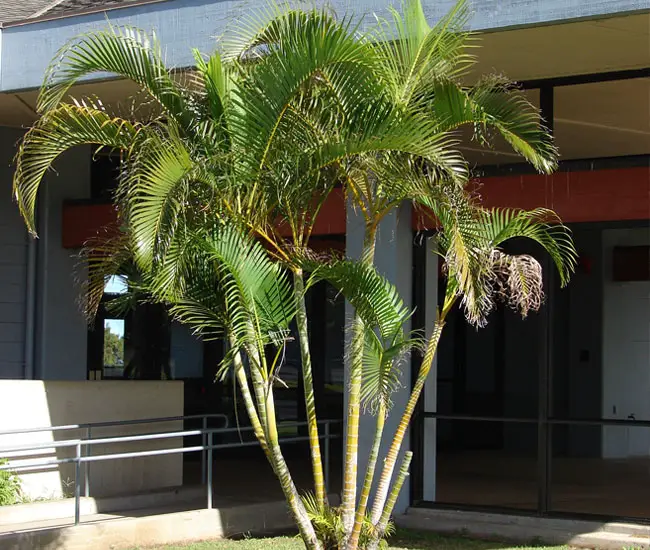
No Trunk Palms
Some palms keep it low-key with a tiny trunk that might show up after many, many years, or they skip the trunk altogether, like the Cat Palm and Needle Palm.
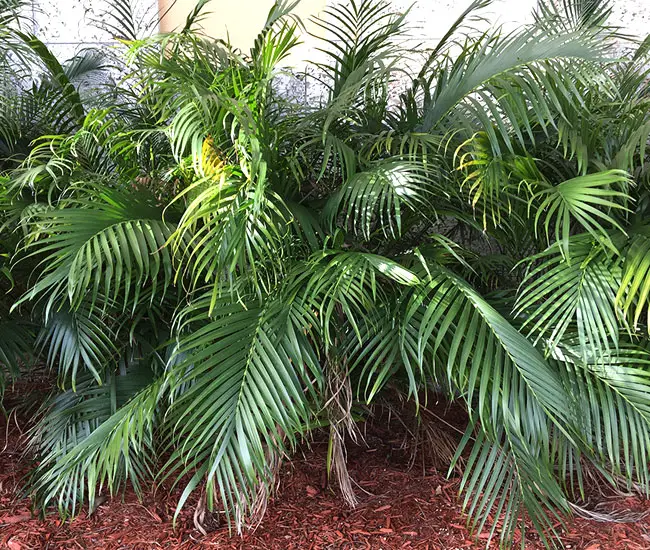
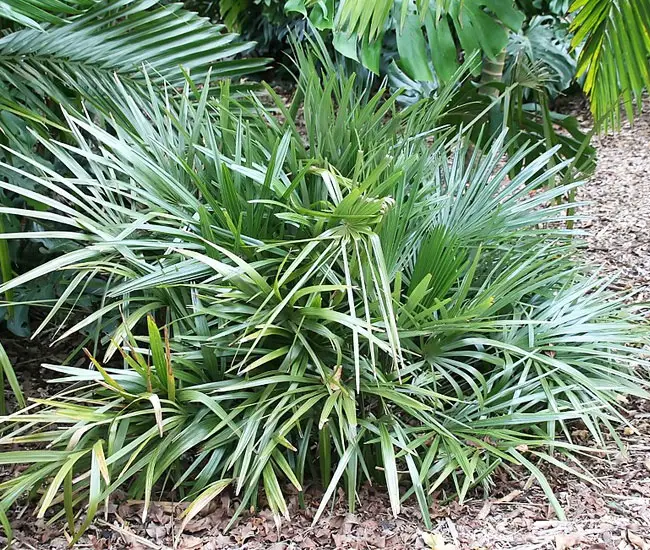
Palms With Self Cleaning Trunks
Now, let’s talk about trunk surfaces – they’re quite the diverse bunch. Some have smooth surfaces that wear scars from old leaves, while others boast a rough exterior covered in old leaf bases, forming a cool crisscross pattern.
Check out the Carpentaria Palm and Alexander Palm as prime examples of palms with “self-cleaning” trunks. A “self-cleaning” means their leaves drop off without the need for pruning.
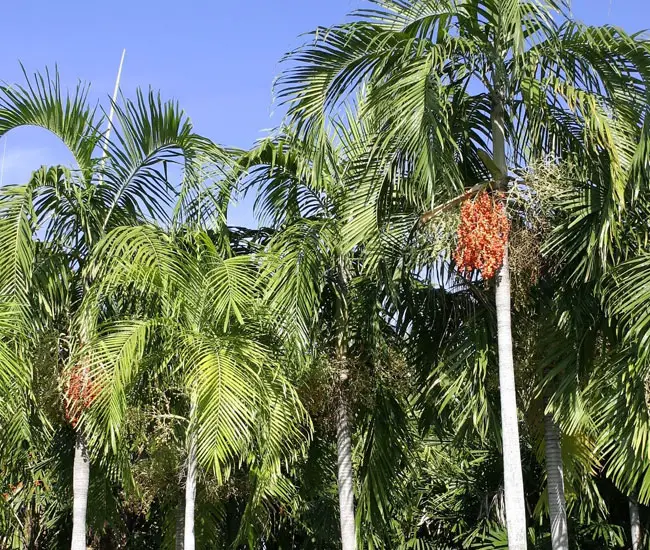
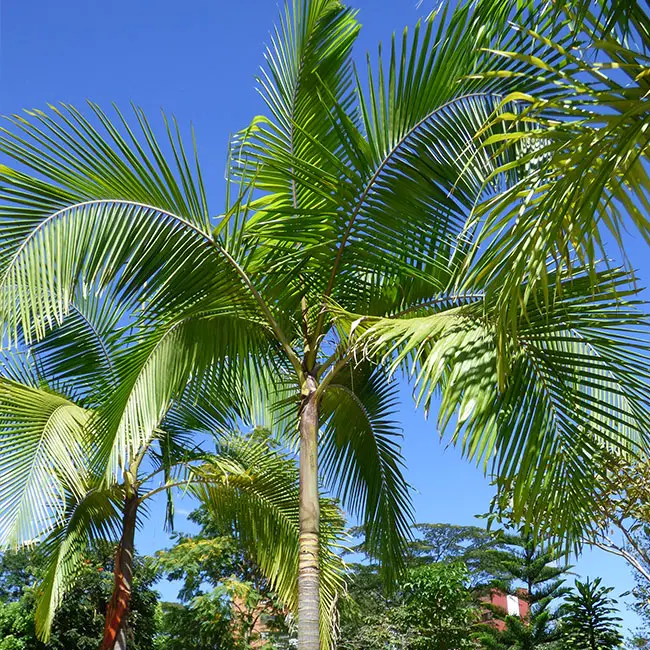
Old Leaf Bases Trunks
When palm leaves say their farewells, they sometimes leave behind a leaf base.
After leaves die, they drop off sometimes leaving a leaf base. Some of the palms with trunks covered with old leaf bases are the Bailey Copernicia Palm, Cabbage Palm, Sylvester Date Palm, Caranday Palm, and Date Palm. These trunks look especially attractive when given regular pruning.
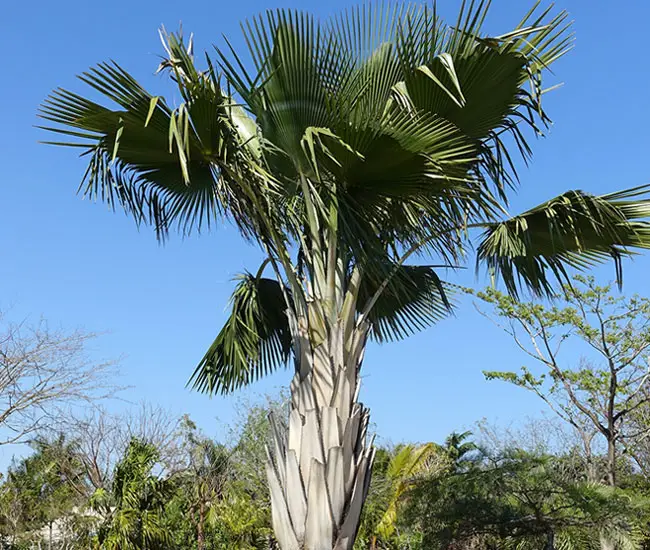
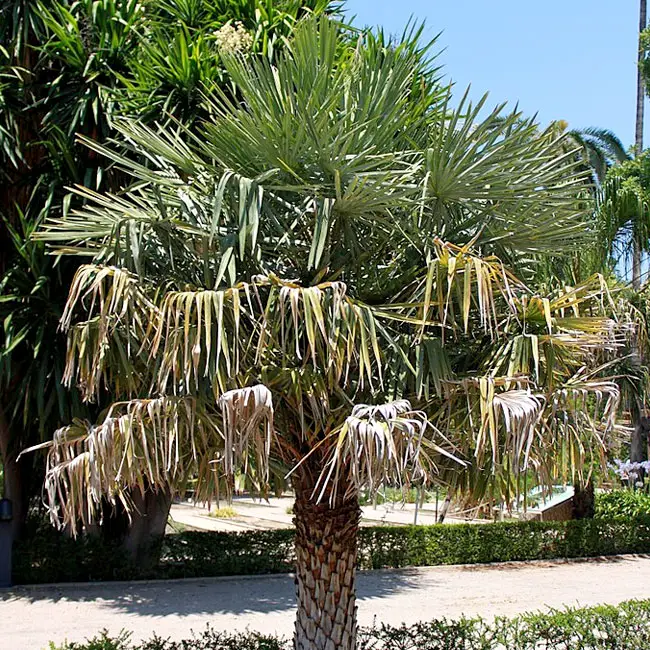
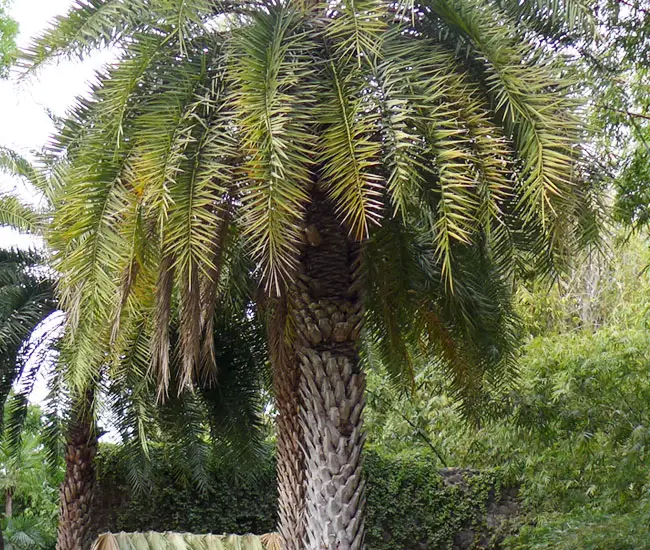
Different Trunk Texture
The trunks’ texture varies, with some palms featuring fiber covering, peg-like leaf bases, or even spines. For instance, the Old Man Palm gets its name from a trunk cloaked in fibers.
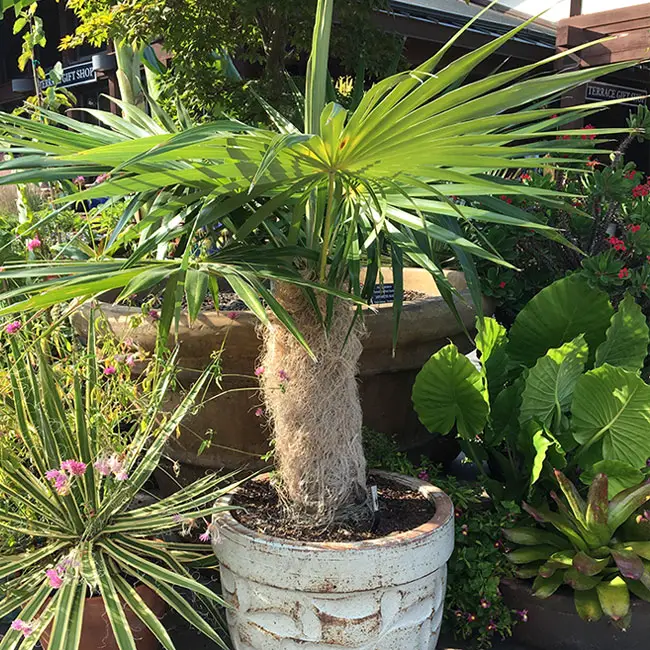
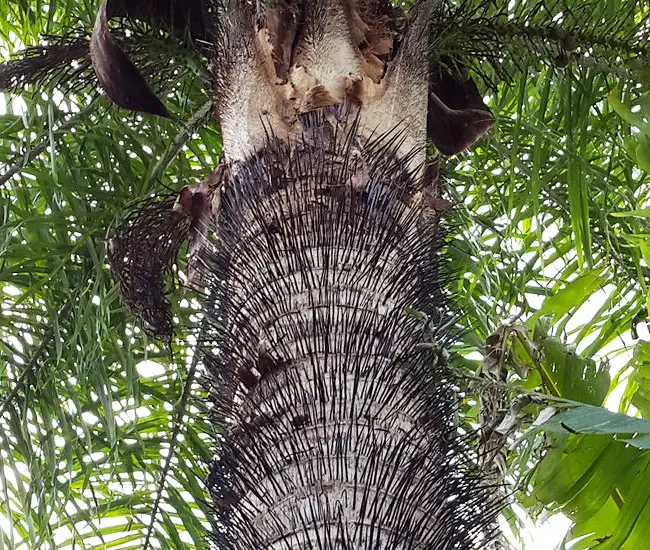
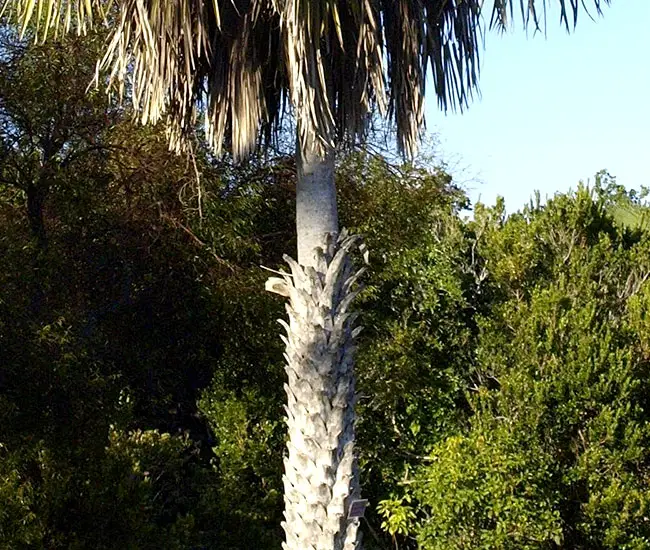
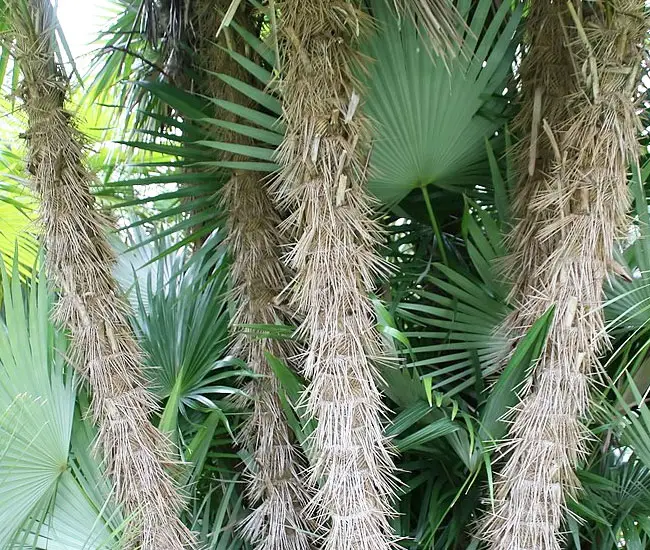
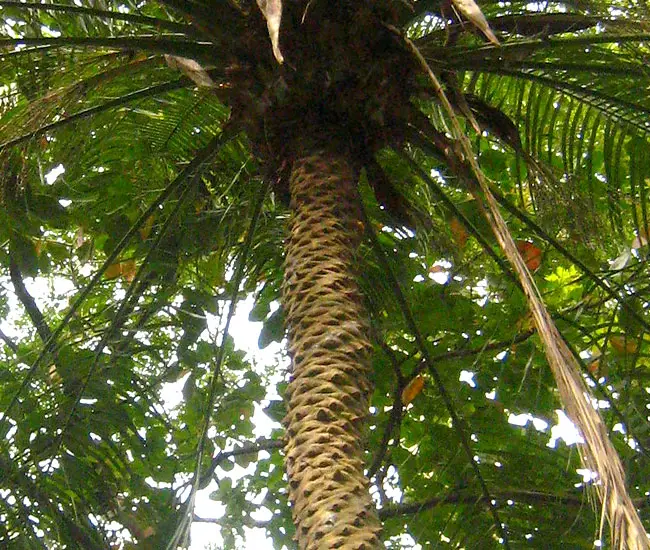
Swollen Trunks
Trunk thickness can also vary significantly. Consider the Bottle Palm; it showcases a smooth, bottle-shaped trunk that widens toward the base.
In contrast, the Cuban Belly Palm has a slender base that swells in the middle, which explains its common name.
The Spindle Palm showcases a ridged trunk, starting narrow at the base and widening in the middle, resembling a spindle.
Meanwhile, the Ponytail Palm sports a swollen base trunk that acts as a water reservoir, making it exceptionally drought-tolerant.
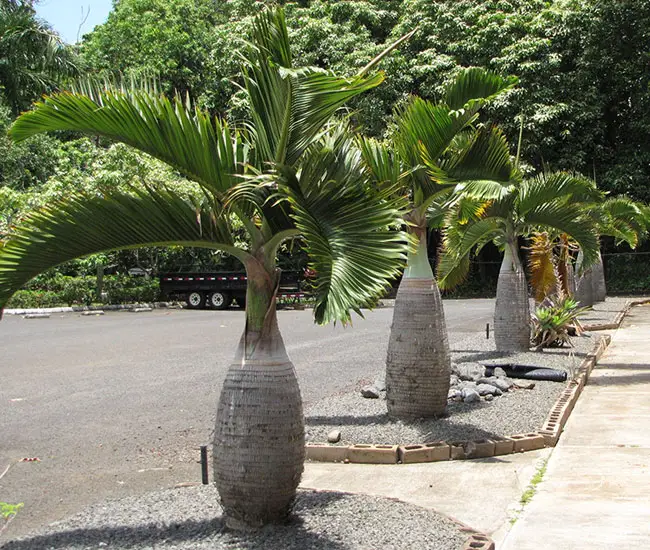
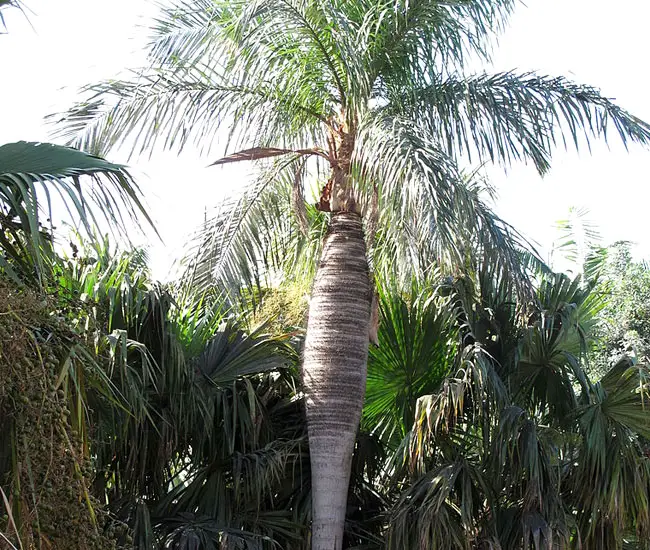
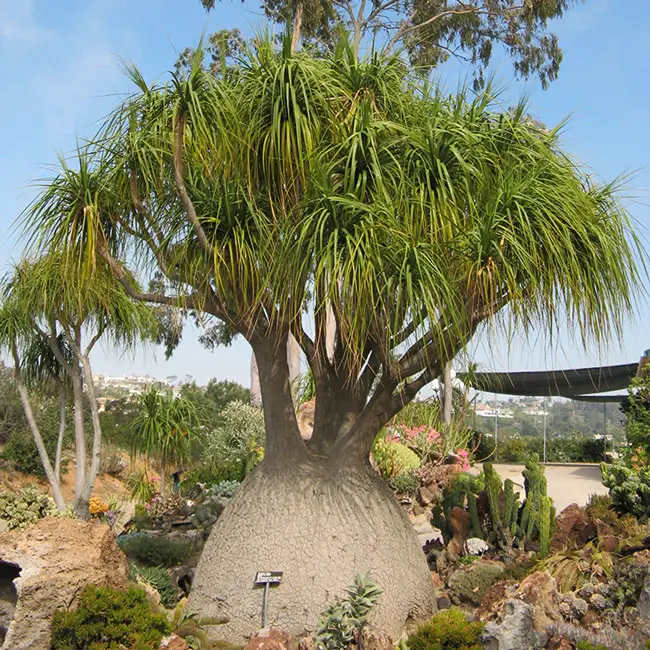
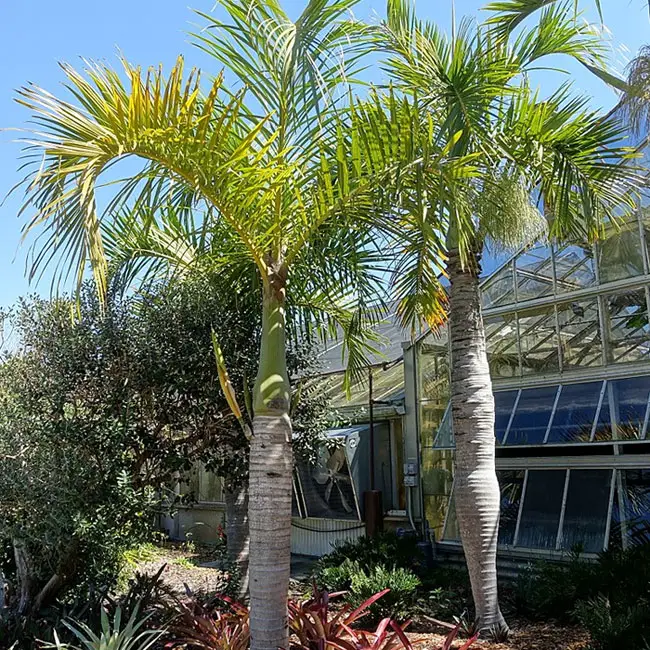
Palm Identification By Flowers and Fruits
Palms may not flaunt extravagant flowers, often with inconspicuous blooms ranging from yellowish-green to light green.
Typically, these flowers grow in clusters along lengthy stems within the canopy or beneath the crown shaft.
Following these modest flowers, palms produce fruits in the form of berries or nuts, with most being non-edible, except for a select few. These fruits can display a diverse array of colors, making them a valuable identification characteristic.
Palms With Edible Fruits
Among the various palm species, six stand out for their delectable, edible fruits. The Coconut Palm is undoubtedly one of the world’s most recognizable palms, famous for its prized coconuts. The Date Palm, on the other hand, is renowned for its sweet, nutritious dates, which serve as vital sources of food in many countries.
The Acai Palm yields black-purple fruits packed with antioxidants, amino acids, and essential omegas, offering a delightful treat.
Meanwhile, the Jelly Palm produces vibrant orange fruits with a sweet, pineapple-banana-like flavor, perfect for crafting delicious jelly.
Though not as widely recognized as others, the Saw Palmetto Palm produces black-blue berries used for medicinal purposes, particularly in treating kidney and prostate urinary problems. Lastly, the Guadalupe Palm produces small, black fruits with a date-like taste.
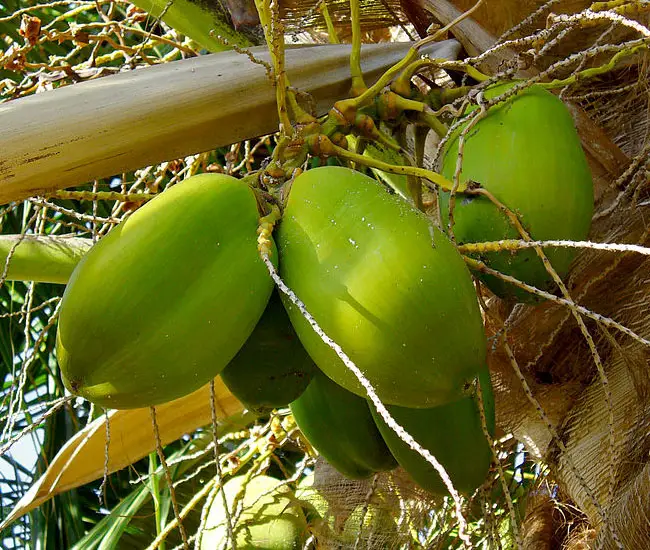
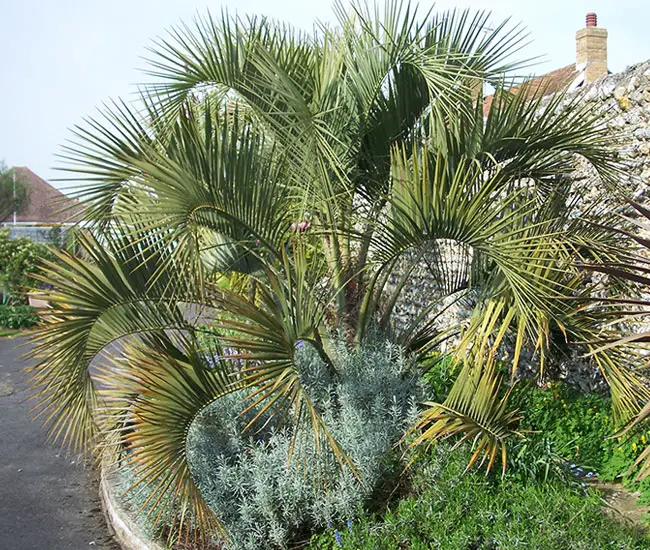
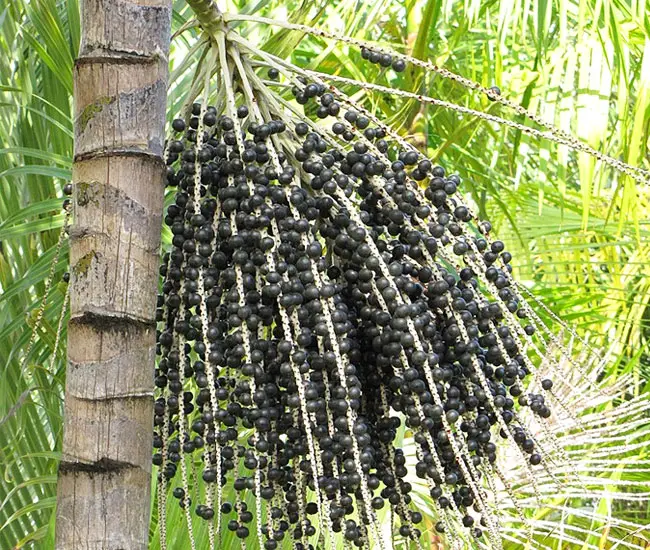
Palm Identification By Size
Palms come in a wide range of sizes, from diminutive dwarf varieties topping out at just 10 feet to towering giants reaching up to 100 feet. Typically, small palms are slow growers, while their taller counterparts tend to develop at a faster pace.
As palms age, they become easier to identify. Young trees, just a few months old, lack distinct features and often appear quite similar.
Palms Characteristics
Each palm possesses unique features that set it apart. Here are the characteristics of the popular palms mentioned earlier:
Areca Palm (Chrysalidocarpus lutescens): A multi-trunk palm that clusters into thick clumps, with yellow-green feather-like leaves. It bears bright yellow flowers followed by yellow-orange berries and can reach a height of up to 20 feet.
Bottle Palm (Hyophorbe lagenicaulis): Recognized by its bottle-shaped single trunk and bright green crownshaft, crowned with feather-like green leaves. It produces small white flowers followed by black berries. This dwarf palm grows to a maximum height of 15 feet.
Coconut Palm (Cocos nucifera): Most famed for its delicious coconuts, it boasts a smooth single trunk and feather-like fronds. It features sweet-scented yellow flowers followed by brown coconuts and can reach towering heights of up to 100 feet.
Date Palm (Phoenix dactylifera): This palm showcases a single trunk adorned with an ornamental diamond-shaped pattern of leaf scars and dark green feather-like fronds. It bears white or yellow flowers followed by edible fruit known as ‘dates.’ This large tree can grow up to 50 feet tall.
Queen Palm (Syagrus romanzoffiana): Distinguished by its smooth single trunk and feather-like fronds, it produces creamy flowers followed by orange fruits. This budget-friendly tree is commonly used in tropical climates and can swiftly grow up to 40 feet.
Old Man Palm (Coccothrinax crinita): A rare and costly tree known for its trunk covered in fibers resembling an old man’s beard. It sports fan-shaped, stiff fronds, yellow flowers, and dark purple fruits. It reaches heights of up to 20 feet.
In Conclusion
Identifying palm tree types can be quite a challenge, given the abundance of varieties. Begin with the fronds, often the easiest part to distinguish. Then, turn your attention to the trunk and stems. Observe the fruits it produces.
Lastly, once you’ve narrowed down the parameters, scout the area for similar trees. Chances are, the palm you’re trying to identify is common to your region. Exotic palms like the Old Man Palm are rare and pricey.
You can refer to palm pictures on our website or use Google Images for reference. On our site, we’ve showcased the most popular palm trees in the USA to assist you in your identification journey.
Related articles:
–Top 10 Most Popular Florida Palm Trees (with Pictures)
–Top 35 Types of Palm Trees (with Pictures)
–Expert Tips: How To Water Palm Trees The Right Way
–How To Plant A Palm Tree In 10 Easy Steps (with Pictures)
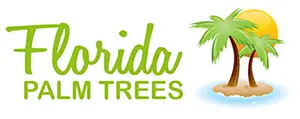
Dear Sir/Madam
Would it be possible to email some photos of our Palm in the hope that you can identify it?
Many thanks
Mark Jones
once again. I am wondering what kind of palm tree this is. a neighbor gave me a cutting of one of her palms. I love this palm and wanted the cutting. it has green front with dark or purpleish backing to the fronds
Fantastic website. Thank you so much! This will be really helpful to those who know nothing at all about how to garden in Florida.
Hey I’m Ashley! My husband and I live in Duluth Minnesota right now but are planning on moving down to Sarasota Florida in the summer of 2016, we are very excited. We plan on having roots down did I mention we are excited?!?!?! ☺ I was looking up palm trees and came a cross yours. Its very well explained and I will continue to learn more. I do have tree well its my moms but I think its mine. Well anyway its a plant but its looks like a miniature tiny palm tree maybe a foot half. I would like to send you a picture of it. I don’t know what kinda plant it is, its adorable though. Well thanks for your time!
Ashley
I need help identifying a palm tree with berries that’s growing in my backyard. I recently bought a house in this palm tree was already there. Is there a way I can send you a picture to help identify it?
I would like to buy these Palm trees, but I don’t know their name. Please help me to identify them.
1) About 10 feet tall, fan shaped leaves, cluster of blue berry fruit.
2) about 10 feet tall, fan shaped leaves, coconut fruit, yellow cluster flowers. Both Survive in Washington state (cold, rain, zone 9)
Thank you
hi I have two palms I think are canary palms I had from a ggod garden centre which said that’s what they are ..they have some sharp leaves on them and it grows from a single trunk ..is it a canary palm please and will they grow fruit ive got hem in tubs ..thankyou..Sharon…
I have a palm tree in my yard that nobody can identify and it’s been here for probably 30 years and it just started to seed and I wanted to see if somebody could identify it because nobody from the Palm Society in the past has been able to
I’m moving to srbring , Fl in a week and would like to know what palm trees I can grow there? I love queen,king,royal& foxtail & almost all tropical flowers, as Canna’s, bird of Paradise, and the many different banana palms. Thank you for any information you can provide and if the trees and plants I’ve mentioned can be grown in that part of Florida? And any suggestions.
looking to buy or grow a small palm tree and transport it to NH ( in Summer) and back to Florida in Winter.. thank you.
I recently moved to Florida. We gave a Palm in landscape and I have no idea what type, how big it gets, if previous owner planted in good location, how fast it grows, etc.
I am looking for tall palms for back yard and a relatively large taller palm as focal piece near front door in landscape. Can I send picture of tree and you give me suggestions?
Also any suggestions on palms would be greatly appreciated. We are 34613 zip. So not sure what trees are appropriate for this area. I like the tall trees with dark, stiff, type fronds..I also like the multi-trunk (2-3) in grandmother’s yard. And the type that has bottle type trunk.
Please help. If I know where to send pics for your help.
Thanks
On your Florida-Palm-trees.com site it would be nice if maybe you put another section on what palm species produce edible fruit/nuts/berries, and then maybe you can have another spin off of that page and have another on how to process them for at home consumption, How to tell when they are at peak ripeness, and maybe a little historical facts about each species like where it originates from, (country and culture/religious history of the species) and lastly what kind of recipes/dishes are favored by there native lands people, for a little bit of multicultural expiraments that may indulge the minds and taste buds of the Americas and beyond! Just a friendly suggestion :) I look forward to hopefully hearing from you and coversing about palms!
Me again! Just forget to say this in last post, I live in a zone 3/4 area, (Northern Vermont) the only palms I can grow are first-of-all indoors or in greenhouse/conservatory which I don’t have the latter two, wish I did but I have a pony tailed Palm and am thinking about buying from Logee’s greenhouse and nursery a dwarf date palm that I never new existed so really excited that it can fit in my home aswell as produce edible fruit! I love tropical palms/plants/edible exotic fruit-bearing plants but am restricted right now to living in this freezer! Maybe, since the earth is getting warmer the zones will change up north in my life time and I’ll get to grow something outside that’s more exotic like the cool palms you produce and provide. This is probably just a fantasy, hopefully we make change to the environment before it gets this bad!!
Roughly how long (in years) does it take for a ponytail Palm that’s 6″ tall from soil level to top of greenery to grow to about ceiling height (mine is 8′ tall) ish?
Oops my ponytail Palm is 6 inches tall and ceiling is 8 feet tall!
I live part-time in Puerto Vallarta, Mexico and my hobby is identifying trees. I have been having a hard time identifying some palm trees and your article came up in my search. I found it very helpful. Can you give me some clues to distinguish among King palms and distinguish them from Royal, Fox tail and Queen. They all have crown shafts and look alike to me at first glance. I think I have Royals down because of the swelling in middle of the trunk. Some ‘keys’ and internet sources would be helpful.
Al Rouyer
I visited Fort Myers, FL recently, and found some beautiful rope/braid-like “pods(?)” under a tree. They average about 10-12 inches long. Most are brown, but some were still green. I have pictures of them, but I didn’t think to get a picture of the tree itself. The closest thing I’ve been able to find on the internet is the Fishtail Palm, however, I don’t think that’s it. Does anyone know what kind of tree it could be?
How can I distinguish between a Phoenix dactylifera and Phoenix canariensis? They look exactly alike, and I’m even more confused when it’s a male date palm because then it’s identical to the canary island palm.
Thanks
I can’t figure out what is wrong with my palm tree. Can I send you a picture.
Thanks
I have searched and searched but cannot identify my palm. I have taken some pictures I can send your way if you respond.
Thanks
I was given a small palm tree 3 years ago. It had a single trunk and 3 leaves. About 3 ft tall. It now has 8 trunks and is about 12 ft tall. It has bluish fronds like my Bismarkia. It is throwing long sprays of oddly shaped seeds. I think that it must be some sort of branching palm, but doesn’t seem to fit into all of the criteria for any one tree. I live in BCS Mexico, so we have lots of heat and sun, but are actually a desert environment. I can send photos if you think you can help me identify this lovely palm, thank you
Marilyn
I have a Mexican palm that was burned really bad this winter. There is one green leaf left coming out of the middle . It has stopped putting out leafs all together. It is about 20 feet tall. I don’t want to lose this palm! Any suggestions please?
I have both Royal and Queen palms growing in my yard.
I now have some juvenile palms that are a couple of feet high.
Maybe all the ones I have growing wild are queen palms.
This gets easy when they are 10 feet tall, but when just a bunch of fronds sprouting a few feet out of the earth, I can’t tell.
Is there any way to distinguish between juvenile Royal Palms compared to queen palms?
I don’t want any more queen palms, but do want to encourage any Royals.
I am trying to identify a palm in zone 9b, Lakeland,FL. Since the last freeze we had this palm, which I saw in someone’s yard, did wonderful. Not a dead frond on it. I would like to send a picture but can’t figure out how to attach.